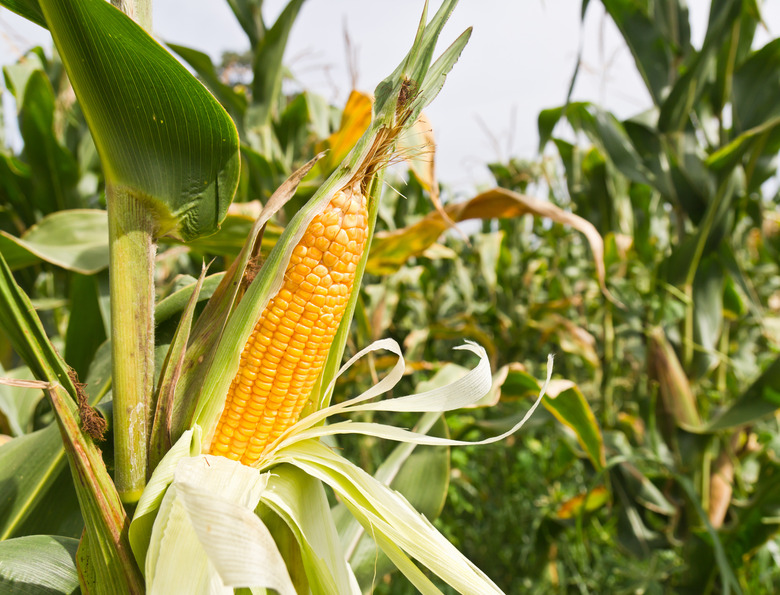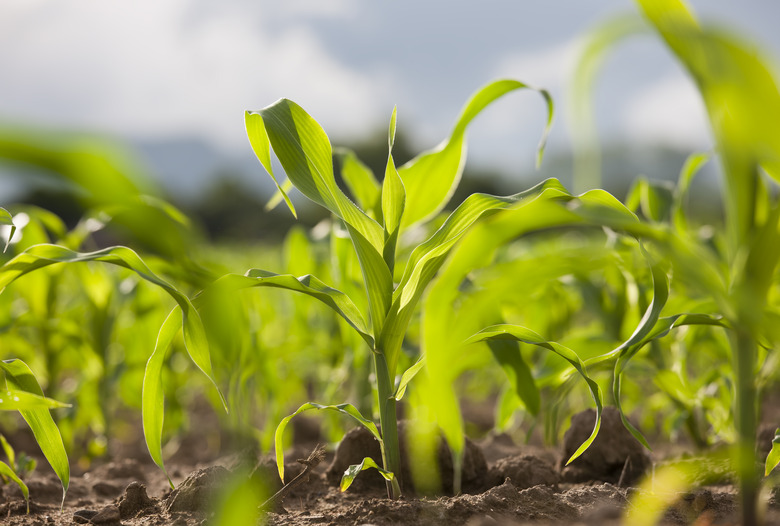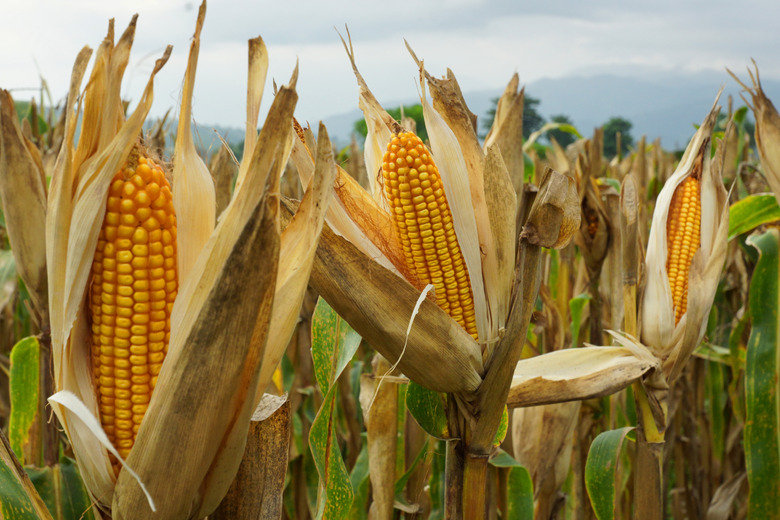How To Grow Corn
We may receive a commission on purchases made from links.
Corn (Zea mays) is a favorite vegetable for the table, and it is remarkably easy to grow, though it takes a fairly large amount of vegetable garden space to grow enough ears for many meals. This is a warm-weather annual plant that is usually harvested in mid to late summer when the early cool-season vegetables have come and gone.
Botanically, corn is actually a highly specialized grass, botanically classified in the grass plant family (Poaceae). The ears and their individual seed kernels are the female flowers, while the tassels at the top of the stalks are the male flowers. Pollen dropped from the male tassels falls onto the silky threads, each of which is attached to an unfertilized female kernel. Without pollination and the resulting fertilization, no kernels can develop on the cob inside the husk. Whenever you find an undeveloped ear of corn, it means that pollination hasn't been adequate.
The Z. mays species covers many different types of corn, including field corn used to feed livestock, hard-kernelled popcorns and colorful, ornamental corns. The cultivars (the cultivated varieties) normally grown in residential gardens for table consumption have been selectively bred to have full, soft kernels with deliciously sweet inner meat. These cultivars are also bred to be resistant to the many disease problems that can plague corn. Among the hundreds of available cultivars of corn, some leading candidates include:
- Bodacious: An early-season, yellow-kernel corn that fully matures in about 75 days.
- Golden Bantam: A midseason, yellow-kernel corn that matures in about 83 days.
- Alpine: A midseason, white-kernel corn that matures in 79 days.
- Athos: An early-season, bicolored corn that matures in 57 days.
- Pilot: A late-season, bicolored corn that matures in 90 days.
- Golden Dwarf: A space-saving dwarf variety that matures in 65 days.
Best Uses for Corn
Best Uses for Corn
Corn is best planted if you genuinely enjoy eating fresh, sweet corn, and if you have ample garden space for the crop. It also helps if you are willing to spend the effort on preserving corn by canning or freezing it. A single stalk of corn typically produces one to three ears, so you will need to grow enough plants to produce plenty of fresh ears for your summer meals. The ears will need to be harvested within a week or so when they ripen, so a good-sized 10 x 10 corn patch can, for a short time, produce so much that you'll need to either share with others or preserve it by canning or freezing.
Corn is a tall, vertical crop that will shade out other vegetables, so be aware that planting sweet corn comes at the expense of garden space that could otherwise be devoted to other edibles. Some varieties can tower as much as 12 feet, although 4 to 6 feet is more typical. If space is limited, you can consider growing one of several good dwarf varieties.
The best companion plants for corn are ground-hugging vine plants, such as cucumbers, pumpkins and squash, which can be planted so the developing vines twine around the base of the stalks. Potatoes can also make good companions for corn. Avoid planting tomatoes or berries around corn. Tomatoes encourage corn ear worms, and fruit berries will lure other pests and birds that eat corn. Beans of all kinds fix nitrogen in the soil, which is of benefit to corn, and you can follow the old tradition of allowing corn to serve as a climbing support for pole beans or plant bush beans around your corn plot.
How to Grow Corn
How to Grow Corn
- Common Name: Corn
- Botanical Name: Zea mays
- When to Plant: Soil
temperature is at least 60 degrees Fahrenheit - USDA Zones: Grow as an annual in zones 2
to 11 - Sun Exposure: Full
sun - Soil Type: Fertile,
well-drained soil - When it's in Trouble: Visible
pest damage or fungal/viral deformities to ears; yellowing, weak stalks;
underdeveloped ears - When it's Thriving: Deep-green, sturdy stalks and leaves; full, robust ears without deformities
Starting Corn From Seed
Corn is generally started from seeds sown directly into the garden. You can soak the seeds overnight before planting to boost germination rates. Sow the seeds 6 inches apart in rows or in small groups of three to five seeds with the groups spaced at least 18 inches apart. The old-school method of planting in long rows is now somewhat discouraged in favor of planting several short rows to form a square corn patch or on a raised hill with several seeds planted in a circle, both of which increase pollination among plants. For a typical family, 12 to 20 plants per person is considered a good number to provide plenty of ears for eating.
Prepare the soil by mixing in plenty of compost (ideally, this should be the fall before spring planting). Sow the seeds 1 to 2 inches deep and immediately water them thoroughly with a gentle sprinkling. Germination rates are generally good, but sowing two seeds in each hole is a good idea. If both seeds germinate and sprout, thin out the less vigorous of the two. It usually takes 10 to 14 days for the seeds to germinate and sprout.
After seedlings appear, keep the patch well weeded and watered throughout the entire growing season. Plucking weeds is better than cultivating because corn has shallow roots that are easily damaged by a hoe. If birds threaten the ears, you can cover the immature ears with paper bags secured with loose ties.
Starting Corn From a Seedling
Seedlings are available at nurseries and can be a good choice if you live in a climate where the soil warms rather late in the spring. In these regions where the soil remains cool in the spring, seeds often get a late start. In order to enjoy ripe ears by midsummer, planting nursery seedlings provides an advantage. Spacing intervals for nursery corn plants should be exactly the same as for seeds.
In What Zone Does Corn Grow Best?
In What Zone Does Corn Grow Best?
Corn is an annual plant that grows well in USDA zones 2 to 11. It grows most vigorously at temperatures between 60 and 95 degrees Fahrenheit, so be wary of growing corn if your summers have temperatures that are regularly outside that range.
When Should You Plant Corn?
When Should You Plant Corn?
Wait until the soil has warmed to at least 60 degrees before you plant. (Various websites will track soil temperatures by region, or you can use a soil thermometer.) Acceptable soil temperatures are usually reached two to three weeks after the last frost in your area. It takes about nine weeks from seed germination for corn to reach harvest maturity, although the precise time depends on the variety you plant and the weather you are experiencing. Seedlings that appear on May 1, for example, will produce pickable ears around the first week of July.
Some gardeners with large spaces like to stagger plantings every two to three weeks to ensure that corn remains available for the table from midsummer into fall.
Soil, Sunlight and Water Recommendations for Corn
Soil,
Sunlight and Water Recommendations for Corn
Corn grows best in fertile, well-draining soil in a full-sun location. It prefers a slightly acidic soil (pH 5.8 to 6.8). These plants require plenty of water during the growing season and even more moisture when the plants begin to flower prior to forming ears. If corn does not get enough moisture, you will notice the leaves curling. Avoid overhead watering when the tassels appear; hard watering can wash away the pollen and hinder the development of kernels on the ears.
Corn plants are heavy feeders, so they should be fertilized regularly with a nitrogen-rich fertilizer or compost. A recommended routine is to side-dress the rows or hills with well-aged compost when the stalks are about 10 inches tall, again when they are 18 inches tall and a third time when the ears begin to show tassels. If you notice a purple color to the stalks, this can indicate a phosphorus deficiency, requiring that you use a phosphorus-rich fertilizer. Performing a soil test eliminates the guesswork.
How to Harvest Corn
How to Harvest Corn
Depending on the cultivar and weather, corn ears will be ready to harvest 60 to 100 days after germinating. Watch the ears, looking for the moment when the tassel silk turns brown and the ears are full and dark green. The kernels should emit a milky fluid when squeezed and not a clear liquid. The harvest usually comes about 20 days after the silk appears.
Harvest the ears by twisting them from the stalk in the morning. After shucking the husks, plunge the ears into cold water immediately, which will help preserve their sweetness.
Immediately after all ears have been harvested from a stalk, the stalk can be cut off at ground level or pulled from the ground, root clumps and all. If you have planted squash or cucumbers among the corn plants, this will open up space for those vegetables to ripen for harvest.
Common Pests and Other Problems for Corn
Common
Pests and Other Problems for Corn
Like many edible vegetables, animal and insect pests can cause problems for corn. This vegetable is even more susceptible to problems than most other edibles.
- Corn borers cause severed tassels, and you may notice waste material pushed out of small bore holes in the stalks. Once affected, the stalks and roots of the plant should be removed and destroyed. If infestation has been severe, make sure to pull out and destroy all stubble at the end of the season, and spray the new crop with a Bacillus thuringiensis (Bt) preparation the following season.
- Flea beetles leave feeding spots and stripes on the leaves, but only very severe infestations truly damage the plant. Keep the ground around the corn stalks clean of debris to prevent flea beetles.
- Cutworms sever a corn stalk at its base, causing it to topple over. The worm is often visible in the remaining stalk. When cutworm moths first appear, spray the plant stems and leaves with Bt to kill the larvae. You can also fashion "collars" from empty toilet paper tubes that you slit along one side and wrap around the stalk, gently pressing each tube into the ground around each plant to provide a barrier for cutworms.
- Ear worms are a very damaging insect, wriggling through the husks to feed undetected on the corn ears. To control them, apply mineral oil to corn silks five to six days after the silk emerges, or mix a Bt product with mineral oil and spray it on the corn crop. It can take several days for Bt to affect the ear worms.
Corn is a favorite food of many four-legged animals, such as raccoons and deer as well as birds. Sturdy fencing and scarecrows are classic potential defenses against animals seeking a juicy ear of corn.
Common Diseases of Corn
Common Diseases of Corn
- Root and stalk rot can cause weak, toppling stalks and underdeveloped ears. It is caused by fungal pathogens in soil that is too wet. Plant corn on well-draining soil to avoid fungal rots. Once infected, plants need to be removed and destroyed.
- Corn smut is a fungal disease that causes black, sooty masses to grow on the stems, ears and tassels. The only solution is to carefully break off affected ears and masses.
- Rust is another fungal infection that causes dull-red spots and splotches on the tops of leaves. It is rarely destructive, however, and can usually be ignored. Keep plants well watered to minimize rust.
References
- Missouri Botanical Garden: Zea Mays
- All New Square Foot Gardening, 3rd Edition, by Mel Bartholomew (Cool Springs Press, 2018)
- Mid-Atlantic Fruit & Vegetable Gardening: Plant, Grow, and Harvest the Best Edibles by Katie Elzer-Peters (Cool Springs Press, 2013)
- Midwest Fruit & Vegetable Gardening: Plant, Grow, and Harvest the Best Edibles by Katie Elzer-Peters (Cool Springs Press, 2014)
- Southwest Fruit & Vegetable Gardening: Plant, Grow, and Harvest the Best Edibles by Jacqueline Soule (Cool Springs Press, 2014)
- Clemson Cooperative Extension: Sweet Corn Diseases
- Clemson Cooperative Extension: Insect Pests of Sweet Corn
- Harvest to Table: How to Grow Corn


